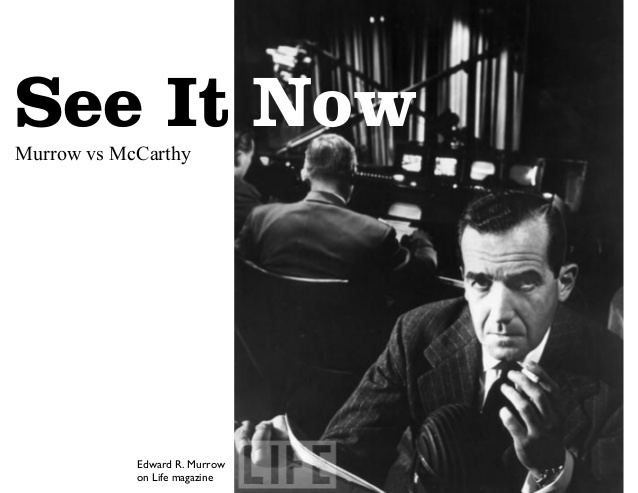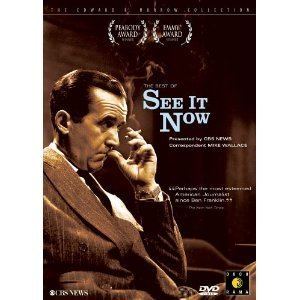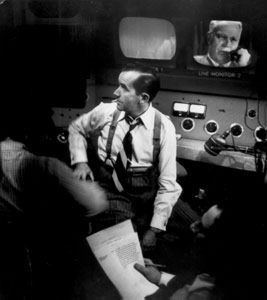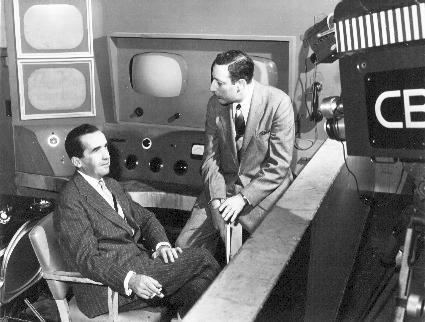7 /10 1 Votes7
Country of origin United States Running time 45–48 minutes Final episode date 7 July 1958 Awards Peabody Award | 6.9/10 IMDb Original language(s) English First episode date 18 November 1951 | |||||||||||||||||||||||||||||||||
 | ||||||||||||||||||||||||||||||||||
Genre NewsmagazineDocumentary Production company(s) Columbia Broadcasting System Similar Person to Person, Army–McCarthy hearings, CBS Reports, Camel News Caravan, Huntley‑Brinkley Report | ||||||||||||||||||||||||||||||||||
See It Now was an American newsmagazine and documentary series broadcast by CBS from 1951 to 1958. It was created by Edward R. Murrow and Fred W. Friendly, Murrow being the host of the show. From 1952 to 1957, See It Now won four Emmy Awards and was nominated three other times. It also won a 1952 Peabody Award, which cited its
Contents


Synopsis

The show was an adaptation of radio's Hear It Now, also produced by Murrow and Friendly. Its first episode, on November 18, 1951, opened with the first live simultaneous coast-to-coast TV transmission from both the East Coast (the Brooklyn Bridge and New York Harbor) and the West Coast (the San Francisco-Oakland Bay Bridge and San Francisco Bay), as reporters on both sides of the North American continent gave live reports to Murrow, who was sitting in the control room on CBS' Studio 41 with director Don Hewitt.
Memorable Episodes

One of the most popular of the See It Now reports was a 1952 broadcast entitled "Christmas in Korea", when Murrow spoke with American soldiers assigned to the United Nations combat forces.
Report of Senator McCarthy

See It Now focused on a number of controversial issues in the 1950s, but it is best remembered as the show that criticized the Red Scare and contributed to the political downfall of Senator Joseph McCarthy.

Murrow produced a number of episodes of the show that dealt with the Communist witch-hunt hysteria (one of the more notable episodes resulted in a U.S. military officer, Milo Radulovich, being acquitted, after being charged with supporting Communism), before embarking on a broadcast on March 9, 1954 that has been referred to as television's finest hour.
By using mostly recordings of McCarthy himself in action interrogating witnesses and making speeches, Murrow and Friendly displayed what they felt was the key danger to the democracy: not suspected Communists, but McCarthy's actions themselves. As Murrow said in his summation:
"No one familiar with the history of his country can deny that Congressional committees are useful; it is necessary to investigate before legislating. But the line between investigating and persecuting is a very fine one, and the junior senator from Wisconsin has stepped over it repeatedly. His primary achievement has been in confusing the public mind as between the internal and the external threats of communism. We must not confuse dissent with disloyalty; we must remember always that accusation is not proof, and that conviction depends upon evidence and due process of the law."
The broadcast provoked tens of thousands of letters, telegrams and phone calls to CBS headquarters, running 15 to 1 in favor of Murrow. Friendly later recalled how truck drivers pulled up alongside Murrow and shouted, "Good show, Ed." The show's probe of the McCarthy-led anti-Communist era is the focus of the 2005 film Good Night, and Good Luck.
Influence and Repercussions
The show was a major influence on TV journalism spawning many successors, most notably of which the recurring documentary series CBS Reports, and 60 Minutes, which was created by See It Now producer Don Hewitt and initially featured former See It Now producers Palmer Williams and Joe Wershba.
Murrow's hard-hitting approach to the news eventually cost him influence in the world of television, although his celebrity talk show Person to Person remained a fan favorite, with better ratings than See It Now had. See It Now occasionally scored high ratings (usually when it broached particularly controversial subjects), but in general it did not score well on prime-time television.
When the quiz show phenomenon took TV by storm in the mid-1950s, Murrow knew the days of See It Now as a primetime fixture on CBS were numbered. After Alcoa ended its sponsorship, the show was moved to Sunday afternoons as a series of occasional specials. During this time, Murrow became agitated by the network repeatedly granting equal time (without consulting Murrow) to subjects who felt wronged by the program. After CBS granted another such request (regarding a See It Now show on whether or not Alaska and Hawaii deserved statehood) Murrow complained to CBS head William S. Paley he could not continue doing the program if CBS continued to accede to such equal-time requests under those circumstances.
Eventually, according to co-producer Friendly, Murrow and Paley had a heated exchange in Paley's office; Paley said he was tired of getting "stomach aches" every time See It Now covered controversial matter; Murrow replied, "That's a price you have to be willing to pay". That exchange marked the beginning of the end for See It Now, which ran its final episode on July 7, 1958.
In September 2006, "See It Now" became the slogan for a relaunched CBS Evening News with new anchor Katie Couric.
